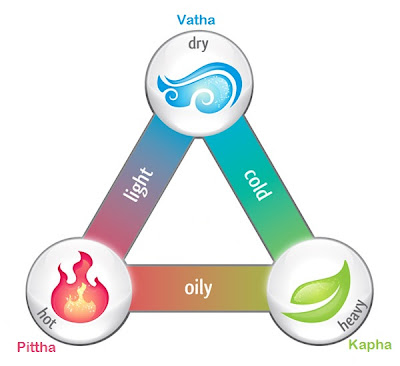Ayurveda
medical science is based on fundamental principles which
govern the function of human bodies on the physical and emotional level. Whole body is made up
mainly Dosha, Dhathu and and Mala. Dosha means bio energies which
control metabolism and all other functions of human body include with mind.
Dhathu means all anatomical elements of the body and Mala means all waste
products like feces,
urine and sweat of human body.
Tridosha
Tridosha
is the main concept of Ayurvedic medical science. It includes three sections.
They are Vatha Pittha and Kapha. The equilibrium of these
doshas provide complete health and imbalance of these doshas lead to various
disorders.
Vatha
Vatha is the most important part of Thidosha concept. It
is a combination of air and space. Vatha is light, cool, dry and can move like
wind.
Vatha is located at large intestine, hip area, thigh
area, ears, bones, bone marrows, skin legs, foot and all part under the
umbilical region. It is being responsible for all movements in whole body
include with mental activities. Including such as blood circulation,
respiration, nerve impulses, speech, sensation, motivation and contraction of
muscles, hearing, touch, excretion, sexual acts, formation of foetus, and
feelings like fear, grief, anxiety and enthusiasm.
When
imbalance of Vatha dosha may lead to a wide range of complications like
anxiety, arthritis, Osteoporosis, constipation, skin dryness, mental confusion
and disconnected speech.
Prana
Vatha, Udana Vatha, Samana Vatha, Vyana Vatha and Apana Vatha are five sub
divisions of Vatha Dosha.
Pittha
Pittha
dosha is a combination of fire and water. It has hot, sharp, oily, light and
mobile qualities. Pittha is located at stomach, pancreas, small intestine,
blood, eyes, skin, taste, synovial membrane, sweat gland and around the
umbilical region.
It is being responsible
for all metabolic activities in whole body such as feeling hunger and thirst,
digestion of foods, makes skin colour, maintains the body temperature,
transformation of all material, converts images into optic nerve impulses and comprehension
of information into knowledge.
When out of balance they
tend toward gastritis, diarrhea, heart burn, Hypertension, migraine, anger, infections,
skin disorders and weakness in the liver, spleen and blood.
There five sub divisions
in Pittha dosha. They are Pachaka Pittha, Bhrajaka Pittha, Ranjaka Pittha,
Sadhaka Pittha and Alochaka Pittha.
Kapha
Kapha dosha is a fusion of
water and earth. It is cool, heavy, moist, dull and dense. Lungs, throat, head,
joints, fat, nose, tongue, taste and mainly thoracic region associate with
Kapha.
It provides the structures
and lubrication in the body. Kapha relates to produce healthy offspring,
prevent excessive friction from occurring between the various parts of the body,
perform strength of physical body and maintain stability of mind.
When imbalance of Kapha
dosha may lead to various types of disorders such as congestion, Obesity,
allergies, swelling, thirst, asthma, cough somnolence and Sinus problems.
Kleshaka
Kapha, Sleshaka Kapha, Bodhaka Kapha, Tharpaka Kapha and Awalambaka Kapha are
five types of Kapha Dosha.
